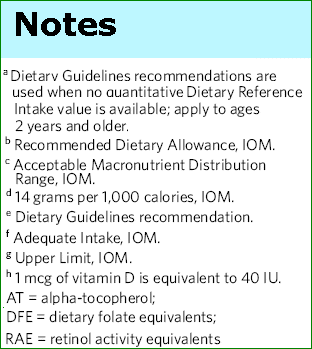Nutritional goals for groups at or near retirement
 From the USDA/USDHHS Guidelines Key Recommendations: “Individuals should meet the following recommendations as part of a healthy eating pattern and while staying within their calorie needs.
From the USDA/USDHHS Guidelines Key Recommendations: “Individuals should meet the following recommendations as part of a healthy eating pattern and while staying within their calorie needs.
Increase vegetable and fruit intake.
Eat a variety of vegetables, especially dark-green and red and orange vegetables and beans and peas.
Consume at least half of all grains as whole grains. Increase whole-grain intake by replacing refined grains with whole grains.
Increase intake of fat-free or low-fat milk and milk products, such as milk, yogurt, cheese, or fortified soy beverages.
Choose a variety of protein foods, which include seafood, lean meat and poultry, eggs, beans and peas, soy products, and unsalted nuts and seeds.
Increase the amount and variety of seafood consumed by choosing seafood in place of some meat and poultry.
Replace protein foods that are higher in solid fats with choices that are lower in solid fats and calories and/or are sources of oils.
Use oils to replace solid fats where possible.
Choose foods that provide more potassium, dietary fiber, calcium, and vitamin D, which are nutrients of concern in American diets. These foods include vegetables, fruits, whole grains, and milk and milk products.
For individuals ages 50 years and older-Consume foods fortified with vitamin B12, such as fortified cereals, or dietary supplements.
 Select an eating pattern that meets nutrient needs over time at an appropriate calorie level.
Select an eating pattern that meets nutrient needs over time at an appropriate calorie level.
Account for all foods and beverages consumed and assess how they fit within a total healthy eating pattern.
Follow food safety recommendations when preparing and eating foods to reduce the risk of foodborne illnesses.”
Full USDA/USDHHS guidelines can be found here.
